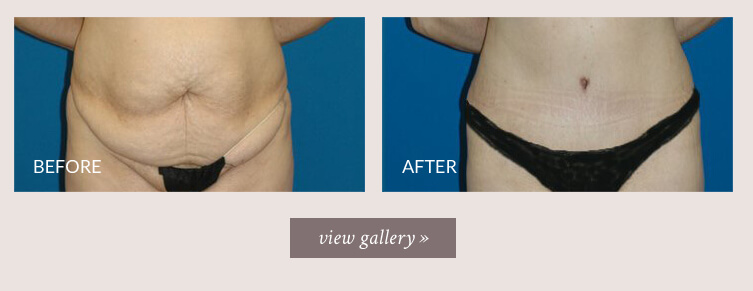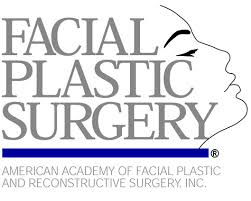Tummy Tuck
Abdominoplasty (Tummy Tuck)
Abdominoplasty or tummy tuck is a surgical procedure designed to tighten, shape, and rejuvenate the abdominal area. Many women experience abdominal bulging, excess abdominal fat and skin laxity after pregnancy. These changes are often resistant to diet and exercise. The procedure is frequently combined with other surgical procedures, such as breast augmentation, breast lift and liposuction, as part of a mommy makeover surgical procedure.
The abdominoplasty procedure removes excessive skin and fat in addition to tightening of the stretched abdominal muscles. This surgical procedure profoundly improves the appearance of the abdominal wall in a way that liposuction alone and other non-surgical alternatives such as Thermage are not capable of doing. There are two general types of abdominoplasty procedures:
- Full abdominoplasty
- Mini abdominoplasty
A full abdominoplasty procedure is designed for individuals with abdominal laxity above and below the belly button, in addition to excess skin and fat. A mini abdominoplasty procedure is designed for individuals with a smaller area of skin laxity below the belly button. A mini abdominoplasty is not intended for patients with any tissue laxity above the belly button level. The mini-abdominoplasty results in a shorter abdominal scar. Both procedures can be combined in conjunction with liposuction of the hip and flank region.
What can abdominoplasty achieve?
An abdominoplasty or tummy tuck procedure can remove excess skin and fat as well tightening the loosened muscles of the abdominal wall to reduce the bulging out of the lower abdomen. The incision is typically well concealed beneath the level of the underwear or a bikini bottom.
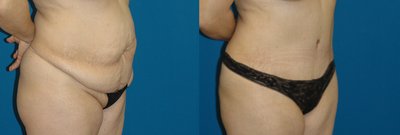
Before and After Tummy tuck procedure. * Individual results may vary.
Click on thumbnail to begin viewing slide show.
* Individual results may vary.
Typical Steps Performed During A Full Abdominoplasty
During a full abdominoplasty, an incision is made at the bikini line, in the same location as a C-section incision but longer in size. Abdominal skin and fat are both elevated from the underlying muscles after isolating the belly button and leaving it attached to the abdominal wall.
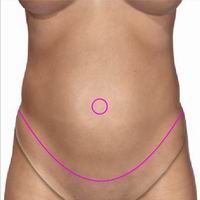
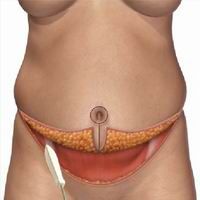
A curved incision is made at the bikini line and the skin and fatty tissues are lifted off the muscle layer up to the level of the rib cage.
Laxity of the abdominal wall muscles is treated by suture tightening of the rectus abdominus muscle (commonly know as the abdominal muscle). This maneuver tightens the abdominal wall, and also can slim the waistline. Sometimes, a horizontal row of sutures can be added to reduce bulging out of the abdomen.
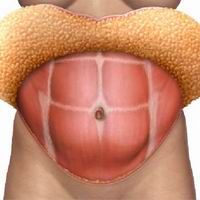
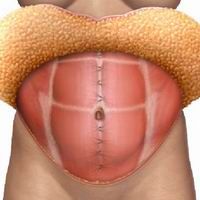
Lax abdominal muscles are then repaired with a suture along the midline.
With the structural components of the abdominal wall tightened, the abdominal skin and fat layer are placed back down. Excess skin and fat are trimmed away and a new hole is made for the belly button. The wound is closed with several layers of dissolving sutures. Drainage tubes are also placed that will remove excess fluid that may build up between the muscle and abdominal tissue layers. If the patient desires, a special device (On-Q Pain Pump) that trickles numbing medication directly into the surgical area can be placed at this time.
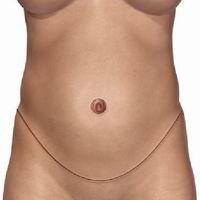
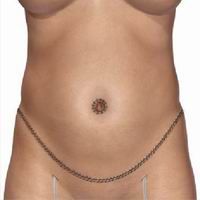
The wound is closed with sutures and drainage tubes are placed.
Typical Steps Performed During A Mini Abdominoplasty
During a mini abdominoplasty, an incision is also made at the bikini line, in the same location as a C-section incision but not as long as the one required by the full abdominoplasty. Abdominal skin and fat are both elevated from the underlying muscles up to but not beyond the belly button.
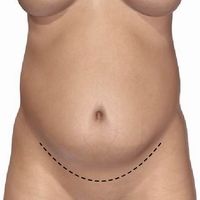
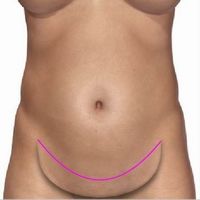
A curved incision is made at the bikini line and the skin and fatty tissues are lifted off the muscle layer up to the belly button.
Laxity of the lower abdominal wall muscles is treated by suture tightening of the lower half of the rectus abdominus muscle (commonly know as the abdominal muscle). This maneuver tightens the abdominal wall, and also can slim the waistline. Sometimes, a horizontal row of sutures can be added to reduce bulging out of the abdomen.
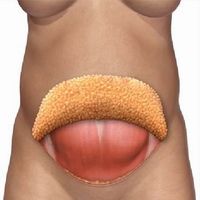
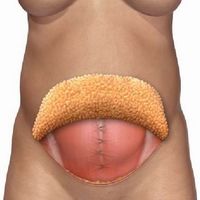
Lax abdominal muscles are then repaired with a suture along the midline.
With the structural components of the abdominal wall tightened, the abdominal skin and fat layer are placed back down. Excess skin and fat are trimmed away and the wound is closed with several layers of dissolving sutures. Drainage tubes are also placed that will remove excess fluid that may build up between the muscle and abdominal tissue layers.

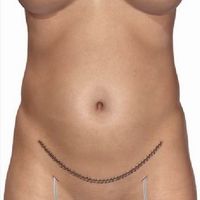
The wound is closed with sutures and drainage tubes are placed.
Abdominoplasty And Hernia Repair
Patients often ask if a umbilical hernia can be repaired at the time of tummy tuck surgery. If the hernia is small and limited to the region of the umbilicus, it can be repaired at the time of abdominoplasty surgery. Other types of hernias, such as ventral and incisional hernias, can be repaired at the time of abdominoplasty if they are small and reducible. Your insurance company may pay for the repair of these hernias.
A rectus diastasis is a separation of tissues between the rectus muscles creating abdominal bulging. A rectus diastasis is not considered to be a hernia and is not a functional problem. A rectus diastasis is repaired during a tummy tuck procedure as part of the abdominal wall tightening procedure. Repair of rectus diastasis is not covered by insurance companies.
What type of anesthesia is used?
A standard or extended abdominoplasty is generally performed under general anesthesia. Mini abdominoplasty may be performed using IV sedation.
What is recovery like?
After tummy tuck surgery the abdomen is wrapped using a comforting abdominal binder that supports the surgical site and helps to ease swelling in the area. Patients are discharged home on the same day of surgery. If the patient desires, a stay-at-home nurse can be arranged to aid in recovery, help with the drain tubes and pain pumps, and ensure the patient is well hydrated and comfortable after surgery.
Most patients are back at work full-time at 2 weeks post-op. Walking is encouraged a few days after surgery. Activity is limited to easy walking and non-weight bearing activities for 3-4 weeks after surgery. Weightlifting greater than about 40 lbs should be strictly avoided in order to not disrupt the repair of the abdominal wall laxity. This restriction includes lifting children off the ground. A good rule of thumb to follow is 'if it hurts to lift something, it's too heavy, ask for help.' The drainage tubes are removed around 10-14 days after surgery. The patient is permitted to resume vigorous exercise at about 8 weeks after surgery. When combined with breast augmentation or other mommy makeover procedures, the recovery time is about the same for a tummy tuck alone.
I am interested! What do I do next?
If you are considering this procedure we encourage you to complete this Surgical Consultation Intake Form. Dr. Hurvitz will tell you whether you are a suitable candidate for an abdominoplasty procedure and whether you would benefit more from a mini or a full abdominoplasty procedure. You will also have a chance to view before and after photo albums of patients who have undergone procedures similar to what you are considering.


